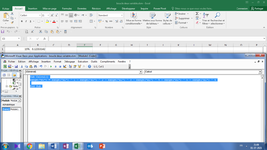Hello
I have a Monster function,
is that possible to make this function inVBA ?
A1 = 15%
B1 = +POWER(A1;1)-POWER(A1;2)-POWER(A1;3)-POWER(A1;4)-POWER(A1;5)
witch mean every time we subtract A1 with the increase of power
So My Vba code is :
Is that anyway to make this Code more professional ?
what If I have Power of 56 times ?
Thank you *
note : My windows and Office in French Language
I have a Monster function,
is that possible to make this function inVBA ?
A1 = 15%
B1 = +POWER(A1;1)-POWER(A1;2)-POWER(A1;3)-POWER(A1;4)-POWER(A1;5)
witch mean every time we subtract A1 with the increase of power
So My Vba code is :
VBA Code:
Sub Calculate()
Range("B1") = Range("A1") ^ 1 - Range("A1") ^ 2 - Range("A1") ^ 3 - Range("A1") ^ 4 - Range("A1") ^ 5 - Range("A1") ^ 6
End Subwhat If I have Power of 56 times ?
Thank you *
note : My windows and Office in French Language






